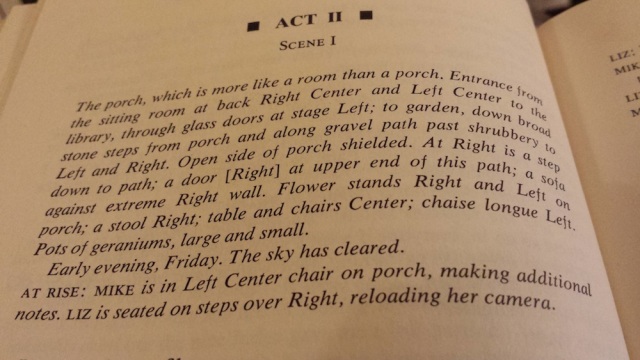After I published my analysis post this past December, “‘What does thee wish?’ To analyze the librarian in ‘The Philadelphia Story’” about the “shushing Quaker librarian” character in that classic 1940 film, I mused in a comment that:
“Perhaps requesting a copy of the play would prove illuminating? I sense an upcoming post…“
OF COURSE I then requested a copy of the original play by Philip Barry, via a regional library consortium system. The play was included in the 1975 compilation States of Grace: Eight Plays by Philip Barry, the penultimate title in the table of contents and Barry’s greatest success on Broadway.
The introduction, written by Brendan Gill, reveals that The Philadelphia Story play not only served as a comeback for Katharine Hepburn, but was a comeback for Philip Barry, as well.
“Phil and I were both box-office poison at the time,” Miss Hepburn has said. “Moreover, our producer, the Theatre Guild, was on the verge of bankruptcy. It was very pleasant indeed for the three of us to make our comebacks together.” (p. 45)
The play made its Broadway debut on March 28, 1939, and ran for over 400 performances. The screenplay was adapted by Donald Ogden Stewart, who was a friend of both Barry and Hepburn. Stewart won the Academy Award for Best Adapted Screenplay, and upon winning, stated, “I have no one to thank but myself!” (as quoted in Melear). Ummm…. no one to thank, huh? Not even Philip Barry?!
A quick glance at the lists of the cast and scenes of the three-act play reveals that there is no corresponding librarian character in the play. The play takes place over a 24-hour period and set entirely on the Lords’ estate near Philadelphia.
Obviously, screenwriter Stewart had to flesh out the play when adapting it for film and added a few scenes outside the Lords’ home. This included the famous intro, an early scene in an office building with reporter characters Macaulay Connor and Elizabeth Imbrie, as well as the scene set in the public library, described in detail in my earlier post about The Philadelphia Story film.
There is mention of a private library at the Lords’ home in Act I. Macaulay, or “Mike,” asks about the family and is told, “The histories of both are in the library.” In Act I, when Mike meets Tracy Lord, she asks if he’s a writer and informs him that she’s “sent for his books.” A bit later, she states condescendingly, “Two books isn’t much for a man of thirty.”
Act II takes place later that night, on the garden porch outside the library.
During Act II, Tracy comes out of the library and walks over to Mike, who is sitting at a table on the porch. In the film, Mike happens upon Tracy reading his book of stories in the public library, where he has gone to research on the Lord family history. Their conversation in the play mirrors much of the dialogue in the library scene in the film.
Tracy: I’ve been reading these stories. They’re so damned beautiful.
Mike: You like? Thanks —
Tracy: Why, Connor, they’re almost poetry.
Mike: Don’t fool yourself; they are!
Tracy: I can’t make you out all, now.
Mike: Really? I thought I was easy.
Tracy: So did I, but you’re not. You talk so big and tough — and then you write like this. Which is which?
About this point in the film, the Quaker librarian comes to shush them… and the rest is reel librarian history. (Or infamy? It’s up to you. 😉 )
It makes sense in the play to incorporate the family research and conversation about Mike’s writing in and around the family’s private library, and it makes equal sense in the film to move those two plot points to an external location and public library. The shushing Quaker librarian was seemingly an invention of screenwriter Stewart’s imagination — perhaps to add another comedic element to the story? She does primarily serve the role of Comic Relief in The Philadelphia Story.
I always find it an interesting exercise to compare play and film versions of a work involving a reel librarian. Almost exactly four years ago, in my “Comparing two desk sets (and I don’t mean furniture)” post, I compared the play and film versions of Desk Set, another dramatic comedy, one starring Katharine Hepburn as reel librarian Bunny Watson.
Sources used:
- Barry, Philip. “The Philadelphia Story.” States of Grace: Eight Plays by Philip Barry. Ed. Brendan Gill. New York: Harcourt Brace Jovanovich, 1975.
- Gill, Brendan. “The Dark Advantage.” States of Grace: Eight Plays by Philip Barry. Ed. Brendan Gill. New York: Harcourt Brace Jovanovich, 1975.
- Melear, Mary Anne. “The Philadelphia Story“. Turner Classic Movies, n.d.
- The Philadelphia Story. Dir. George Cukor. Perf. Katharine Hepburn, Cary Grant, James Stewart, Ruth Hussey, John Howard, Roland Young. MGM, 1940.






“The shushing Quaker librarian was seemingly an invention of screenwriter Stewart’s imagination…” In other words, we have no one to thank for her but himself.
In a stage play, of course, changing location is a major undertaking that involves re-setting the whole stage between scenes (unless you’re going for a more Expressionist approach), but in the movies, it’s easier to pull off. Adding throwaway characters is harder as well, since the actor has to come in night after night, as opposed to one day’s shooting. The public library and librarian makes the world seem more complete and fleshed-out, I would say, but was only worth it for a movie.
I agree. There is a mention of the ‘Pennsylvania Dutch’ in the play, which might have (?) inspired the screenwriter to include a Quaker librarian, but that would be a big leap. Only speculation. But it would be complicated to get into all the differences between the Amish, the Pennsylvania Dutch, and Quakers.